History of magic in Australia: Magicians, escapologists entertained the world
From the Great Levante to Murray the Escapologist and The Amazing Mr Rooklyn, Australia has a daring history of magicians who entranced and entertained.
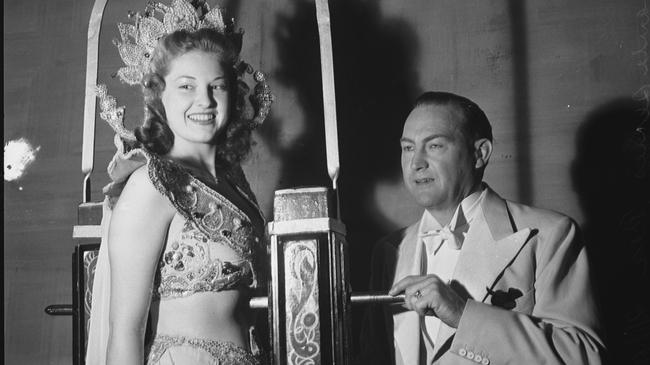
Today in History
Don't miss out on the headlines from Today in History. Followed categories will be added to My News.
It’s hard to imagine what Colonial Sydney would have made of the magic tricks and illusions performed by Thomas Amott in the mid-1800s.
Nine years after the British man arrived as a convict, he was thrilling audiences with classic illusions already popular throughout Europe. Known as the Wizard of the South, his 1836 show in Parramatta was the first official magic performance in Australia.
And so began the history of magic in Sydney.
“Magic became an organised form of entertainment in the 19th Century, before then it was in the realm of fairgrounds and street performers and as such it had an element of conmen and conjurers about it who would perform sleight-of-hand tricks to make money,” says State Library of NSW curator Margot Riley, who worked on the exhibition How’s Tricks? Magic in the Golden Age which opens on Saturday.
“The gold rush really led to magic going through the roof because the growth in population and disposable income created a ready market for this new form of entertainment.”
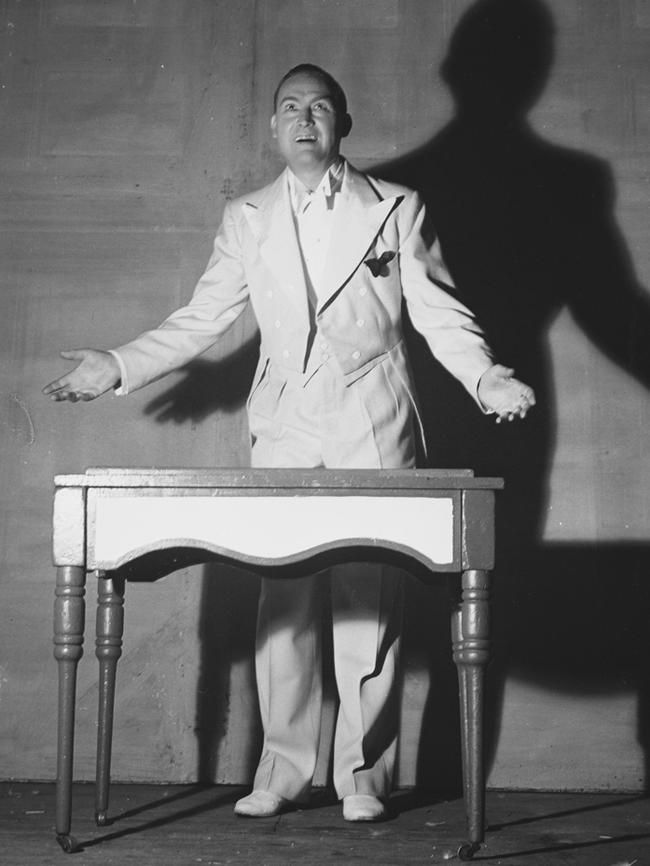
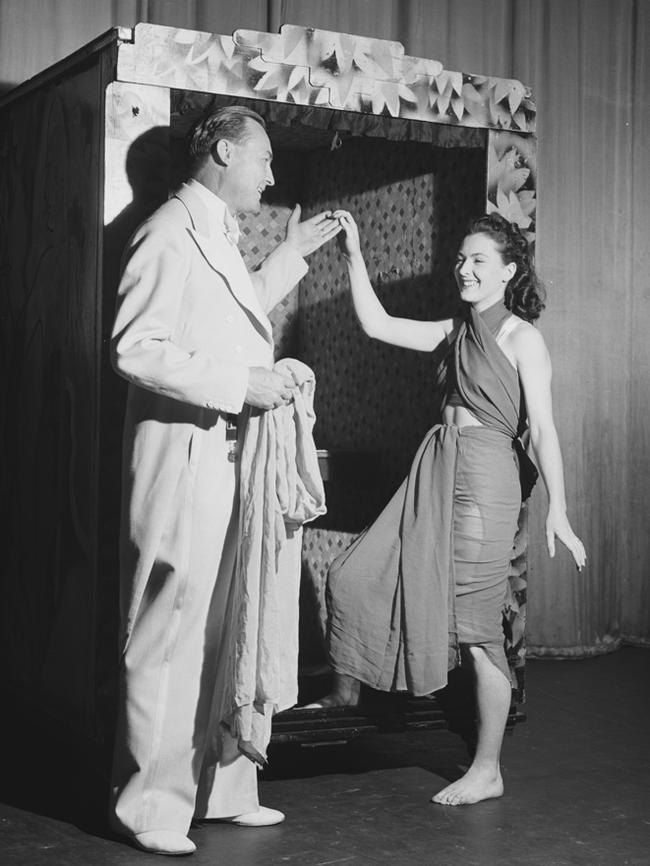
Well-known European and American magicians came to Sydney throughout the 19th Century, the colonial city seen as a viable stop on the world touring circuit.
Scotsman John Anderson, who performed for Queen Victoria at Balmoral Castle and was known as the Wizard of the North, was the first magician to tour the world and came to Australia in 1859.
And when America’s Carter the Great toured Australia in 1907 audiences were thrilled with classic acts such as sawing a woman in half and making an elephant disappear.
By the 20th Century, Australian magicians were making their own mark on home soil and on the international stage.
One of Australia’s most famous illusionists was Lesley Cole, born in the Sydney suburb of Alexandria in 1892 and known professionally as The Great Levante. His love of magic was sparked by a book when he was 10 years old and he started performing by the age of 18.
By 1927 he set off on a world tour with his wife Gladys and daughter Esme, and in 1937 he launched his very popular show called How’s Tricks? In London.
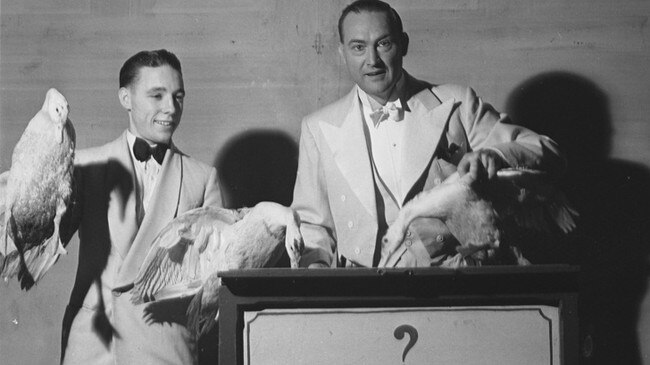
In 1939 the International Brotherhood of Magicians elected him the World’s Number One Magician and that same year the outbreak of war forced him to return to Australia where he continued to tour locally and in New Zealand.
“On one of their tours of England they took Jo Jo the kangaroo with them and Levante’s daughter Esme, who was also his magician’s assistant, would take the kangaroo out for walks on Piccadilly Circus,” Riley says.
“It was a big stunt of course, all part of the promotion of the show. Levante was a very polished showman.”
Levante died at his home in Bellevue Hill in 1978, aged 86.
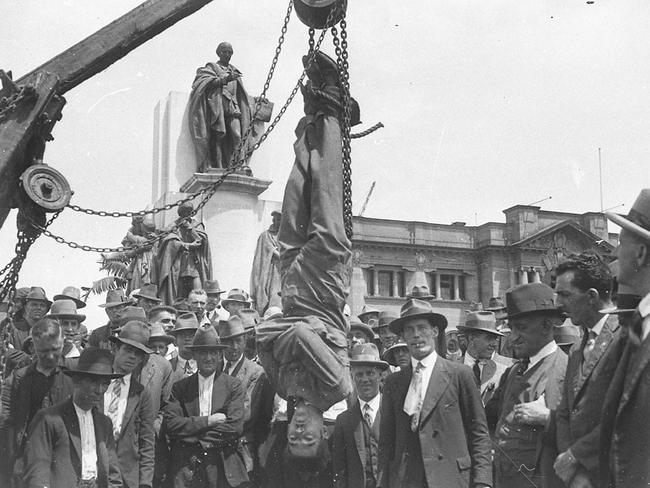
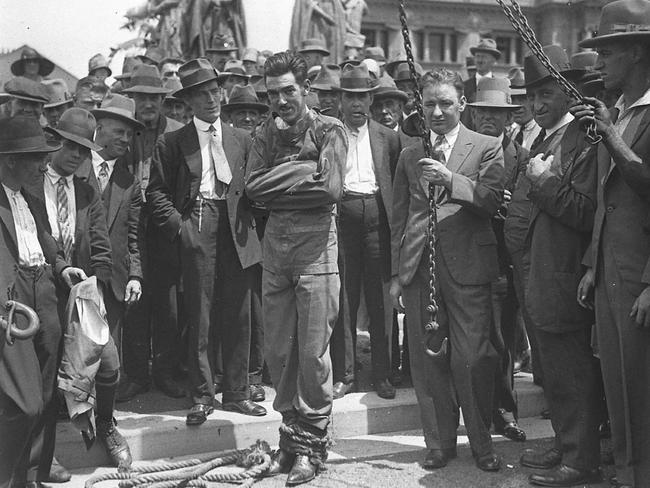
Another Australian performer was Norman Murray Carrington Walters, or Magic Murray.
He distinguished himself as an escapologist at a time when the world was enraptured by Houdini, and by the age of 16 he was touring the world.
In 1926 he topped the bill in London when he was hung upside down from a crane and escaped from a straitjacket. Two years later he famously performed the same stunt outside what is today the State Library of NSW.
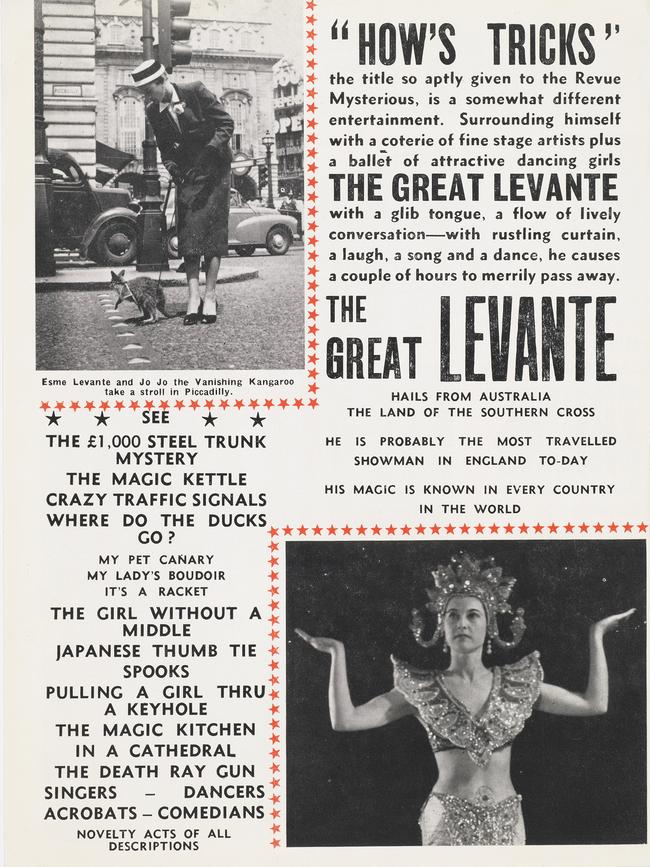
He retired in 1954 claiming “escapology is a young man’s game” and opened the shop, Murray’s Magic Mart, in Blackpool, UK where he died in 1988, aged 87.
The last of the great Australian performers was Maurice Rooklyn, or the Amazing Mr Rooklyn, who was born in London but migrated to Sydney when he was five years old.
As a boy he practised juggling, ventriloquism, illusions and hypnotism for up to 14 hours a day and left his home in Haberfield to tour England when he was still a teenager.
He was known for his billiard ball tricks in which he made balls appear and disappear and change colour and famously had his hands insured for $10,000.
The rise of television, particularly in the 1950s, signalled the end of the golden age of live magic performances.
How’s Tricks? Magic In The Golden Age opens at The State Library of NSW on Saturday, June 26
MOI-YO WAS SIMPLY MAGIC AS AN ASSISTANT
A magic show is nothing without a magician’s assistant. And in 20th Century Australia, there was nobody that shone like Loretta Miller, or Moi-Yo as she was known.
She was ‘discovered’ in the 1930s by touring Danish-born American magician Harry Jensen, later Dante, who upon his arrival declared himself fascinated by Australian women.
He launched a competition to find Australia’s most beautiful woman and Miller was the winning entrant. She was his assistant from the 1930s until his death in the 1950s.
It is believed her nickname, Moi-Yo, was a mispronunciation of her surname while touring in Asia.
SHOPS THAT WERE CONJURED UP LIKE MAGIC
As the enthusiasm for magic grew in Sydney, audiences wanted to replicate the tricks themselves and magic shops sprung up around the city. Will Andrade’s Magic Shop next to the GPO building in Pitt St opened in 1919 and lasted until 1996. It stocked magic supplies, props, books and theatrical products like wigs and makeup and so also became a drop in centre for magicians and performers. There was even a magician’s club in the basement where performers could discuss tricks, learn and practice away from the prying eyes of their audiences. And it also housed the first magic library exclusive for magician’s use.
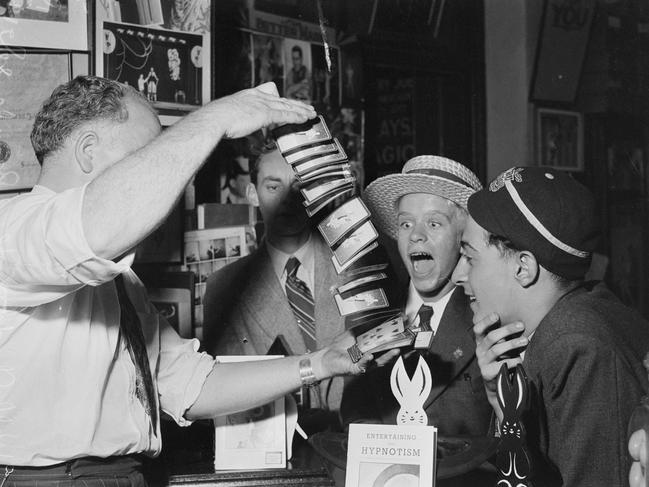
1949 HAUNTING OF MORTDALE HOUSE
When police arrived at a family home in Mortdale on a June evening in 1949, they found a frightened woman at her gate clutching her sleeping toddler. Her husband, firefighter Norman Green, was at work and their other children, nine-year-old Elaine and John, four, were seeking refuge with the neighbour.
Olga Green told police she refused to stay in the Villiers Ave home alone. And they heard as she recounted the strange story of a loud banging that seemed to come from under the house in several rooms, a noise so loud it could be heard from outside.
The first time the rapping was heard under the two-bedroom cottage was Friday, June 11. It was reported in the local newspapers the following day and by Saturday night a crowd of people, police and journalists gathered outside the home as word spread throughout the community — a ghost had taken up residence in the little semi-detached cottage.
By Sunday at least 100 people gathered outside the suburban home as the curious residents of the south Sydney suburb hoped to hear the mysterious pounding for themselves.
News of the ghostly rapping was first announced on Saturday, June 12, with a Daily Telegraph headline that read “Knock knock but no one was there”.
It told the story of Olga Green who fled her home with her three young children. Her neighbour Robert Smith called the Hurstville police and Detective Sergeant Wedlock and Constables Gibb and Townsend arrived to find the unsettling scene.
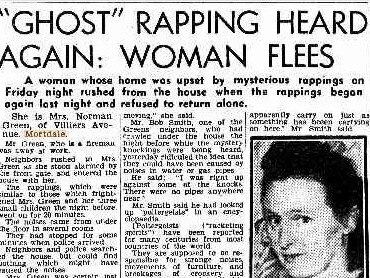
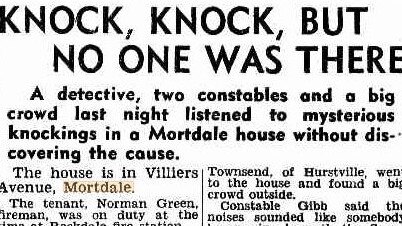
The police heard the hammering sound, which would continue for up to 20 minutes at a time, and which Cons Gibb told the Telegraph sounded like “somebody hammering beneath the floor”.
He also reported the lights flickered on and off inside the house. Another neighbour, Bob Smith, crawled under the house but could not find the source of the banging.
Mrs Green was quoted as saying the sound was like “hard, sharp knocks like hammer-blows”.
She added “when one of the Hurstville police heard them last night he gave such a start that he nearly dropped his cigarette”.
Smith said he didn’t think it was caused by water pipes as he was right up against some of the knocks and there were no pipes.
“If poltergeists exist, they apparently carry on just as something has been carrying on here,” Smith said after admitting he had to look up the word poltergeist in his encyclopaedia.
As the crowd peaked at about 100 on Sunday, theories flew thick and fast about the source of the noise — a ghost, water or gas pipes rattling, a possum or rats — one interested party even suggested it could be a death watch beetle which had bored into the oak furniture and was banging around in there.
A Telegraph reporter brought plumber of more than 30 years, C J Burns, to the scene to test the water pipe theory. He declared he was sure sudden changes in water pressure could cause the rappings.
With theorists and general stickybeaks seeking access to the home throughout Sunday, Mr Green got special leave from work to come home.
“I don’t know what’s causing this rapping noise but I’m sure of this — it’s not ghosts, spirits or poltergeists,” he told reporters.
“I won’t have any of that nonsense. I’ve been pestered all day by people who want to come inside and test theories about spirits and things. On Saturday night a party of people called and took charge of the house. They wanted to move my gas fire out and burn candles in the fireplace to bring a spirit down the chimney.
“My wife was nearly worried crazy by them. I’m more worried about the people who come through the front gate than the noises under the floor.”
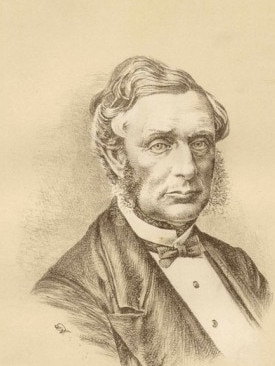
However, Mr Green added water pipes did not run under the house but beside it under a concrete path, and that he had tried to tap the pipes wherever they were exposed and was unable to duplicate the noise.
By Monday, the noise that began from nowhere on Friday night had disappeared and the crowds along with it.
Perhaps the ‘haunting’ of Villiers Ave should have come as no surprise given the meaning of the suburb’s name which was established with the opening of the railway station on March 20, 1897, adding to the little town that had eight years earlier opened a school and a post office.
The suburb on the Hurstville line expanded and grew throughout the first two decades of the new century and was a popular place for soldiers returning from World War I to settle in the 1920s.
As Mortdale translates to ‘valley of death’ in Latin, there have been moves by residents to have it renamed, but its name actually comes from 19th century industrialist Thomas Sutcliffe Mort who pioneered the refrigeration of shipping meat and also gives his name to Mortdale’s main street Morts Rd and Mort Bay, Balmain, after the dry dock he helped establish there.
Got a local history story to share? Email mercedes.maguire@news.com.au
HAUNTING OF SCARIEST STREET
There’s something about a good ghost story that sparks curiosity even among the unbelieving. And with its grisly origins, Sydney has its fair share.
One of the scariest sites is the ‘street with no name’ in Annandale, a laneway that runs alongside a light rail viaduct, and the surrounding Jubilee Park.
While it’s gated and overgrown with brambles today, the story goes it’s haunted by the restless spirits of several dead people, including a railway worker and a young boy in the 1960s.
People have reported feeling suddenly nauseous at the site and dogs and children acting strangely there.
Day a plane landed in DJ’s boyswear department
The $1 billion development at 111 Castlereagh St is tipped to herald a new age of living, working and retail in the heart of Sydney’s CBD. The same was said when the elegant David Jones Men’s Store opened on the same site in 1938.
Back in those inter-war days, going shopping was an occasion — women donning their best dresses with matching gloves, shoes and handbags and men in tailored suits and hats for a day at the shops.
And the stores — David Jones, Horderns, Mark Foys and Grace Brothers — worked hard to attract the retail dollar. Their department stores were a destination.
The David Jones Men’s Store has been closed for years but the new Cbus Property and Scentre Group development will again make the impressive art deco structure a landmark of the CBD.
The sandstone facade has been retained and will comprise a mix of premium office space and luxury retailing, while a new 22-storey apartment tower will rise up above it offering 101 new homes.
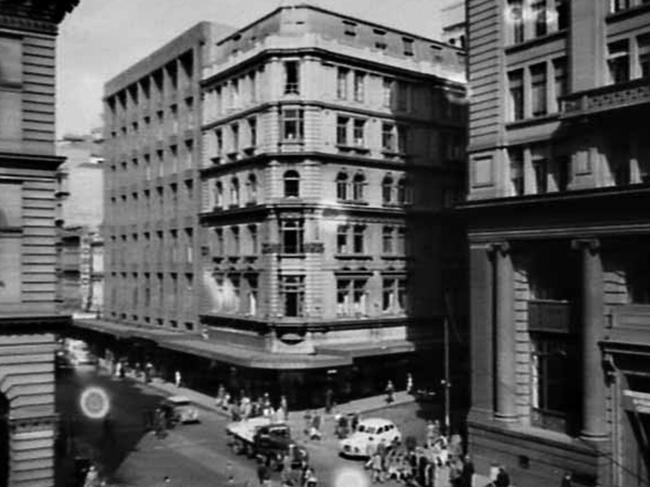
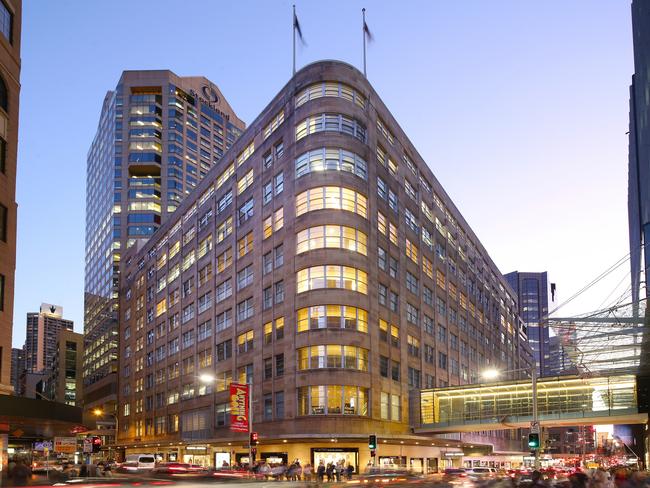
Anna McLaurin, a heritage consultant from Weir Phillips Heritage and Planning, has been working on the site, which initially housed a six-storey building, and was the men’s answer to the flagship David Jones women’s store on Elizabeth St.
Shoppers were greeted by cabinetry on the ground floor filled with stylish hats, gloves and accessories in an open-plan layout designed to encourage impulse buying. On the first floor you would find men’s outerwear — suits, tailoring and a men’s barber shop.
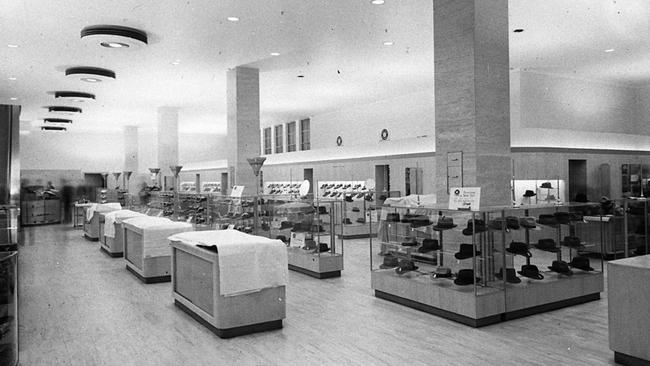
On the third floor was the boy’s department. The remaining three levels initially housed office space, including an advertising department and staff training, but by the 1950s these floors were remodelled into a homemaker’s prestige and furniture floors.
“People made a day of going to a department store like David Jones,” McLaurin says of the inter-war and post-war years.
“You would stock up on everything you needed in the one day — your undergarments, maybe have a suit tailored, get a hat and then stop for lunch at the cafeteria. These department stores knew the value in keeping shoppers in their building for as long as possible, which is why you often found places to lunch there.
“And they would put on extravagant displays to attract people into the stores. The David Jones Men’s Store once had a Swedish Safir aeroplane craned in and set up in the boyswear department on level three.”
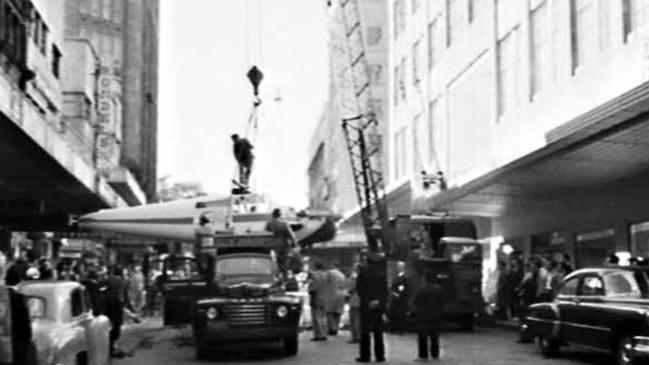
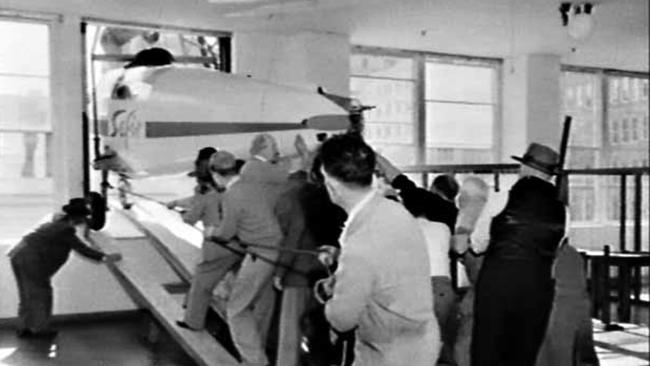
The store’s influence didn’t end on Market St. David Jones released its first shopping catalogue in 1890, establishing a mail order department for people who lived outside of Sydney.
The Inwards Parcels Shed at Central Station — which is today the Railway Square YHA — would receive parcels from retailers around Sydney via a tunnel to be dispatched around Australia.
Only three years after it opened with a rousing speech by then-prime minister Billy Hughes who declared it “a magnificent temple of commerce”, the store was turned over to the war effort and the Ministry of Munitions.
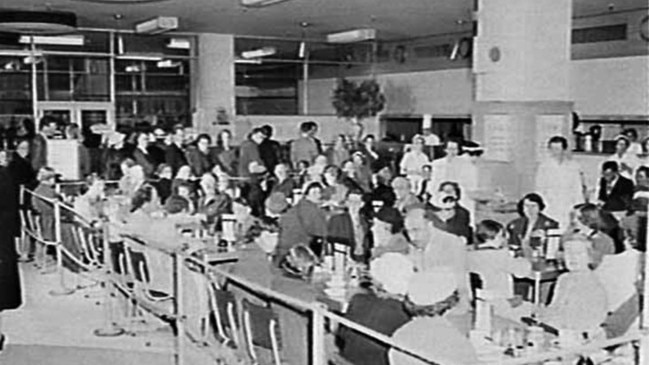
The top floor was even converted to a club for American soldiers.
“When it reopened as a store, there were massive queues and crowds of people who came to buy things that had been denied to them thanks to rationing during the war,” McLaurin says of the 1946 reopening.
“People clamoured to buy previously-scare items like cigarettes, leather goods and even socks.”
McLaurin says much of the historic value of the new building has been retained; the exterior sandstone cleaned, grand internal staircases restored and even the wartime additions redone in keeping with materials available at the time.
“War rations at the time the additional storeys were added in 1941 meant there was a lack of aluminium which was being used for building planes,” McLaurin says.
“Instead, they used timber for the windows and painted it silver. You can see it if you know what you’re looking for and I think it’s great that even these simple elements have been retained.
“It’s all part of the history of the building.”
Got a local history story to share? Email mercedes.maguire@news.com.au
ONLY THE BEST FOR DAVID JONES
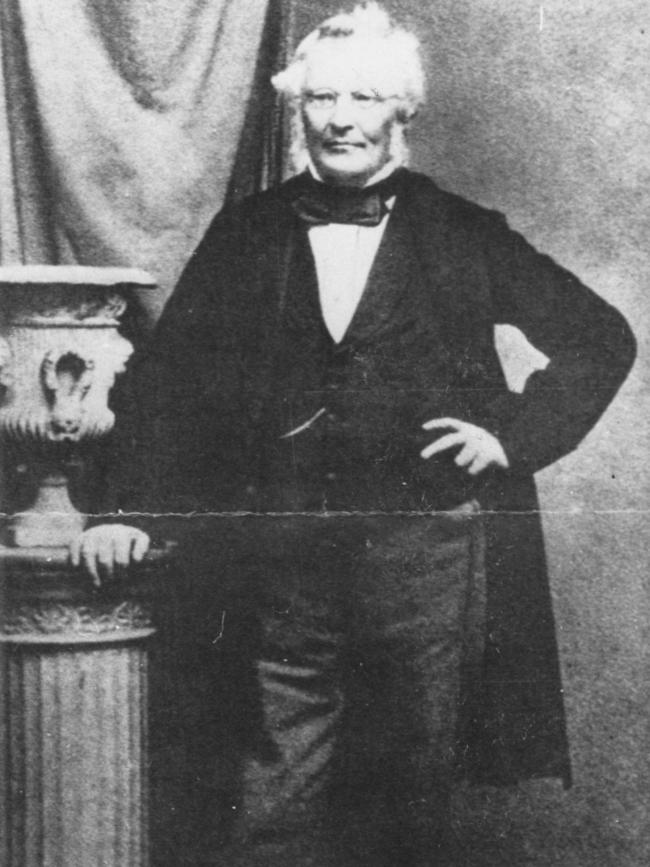
The department store was founded by David Jones, a Welsh merchant, in 1838 who envisioned a retailer that offered “the best and most exclusive goods”.
Initially on George St, the flagship store on Elizabeth St was opened in 1927 under Jones’ son Charles Lloyd Jones, who with his brother Edward, had travelled widely and brought back to Australia the very-European concept of the department store.
In 1938, the David Jones Men’s Store was opened to mark the 100th anniversary of the brand, which is today the oldest continually-operating department store in the world still operating under its original name.
TIME CAPSULE MYSTERY
At the time of the construction of the David Jones Men’s Store in 1937 — which only took nine months to build — the idea to bury a time capsule in the foundation of the building garnered great public interest.
Charles Lloyd Jones Jr, the son of the then-chairman of the store, placed a hermetically-sealed cylinder in one of the steel stanchions of the foundation.
The capsule was removed during the 2000 renovations but the full contents remain a mystery. All that is known is that a copy of the David Jones publication, Heart Of A Great City, was enclosed along with “other items of contemporary interest”.
HOW POLIO SUFFERER BECAME A DISABILITY PIONEER
You may have never heard of Lionel Watts but chances are you or someone you know has benefited from his work.
The man who became quadriplegic after contracting polio at the age of 28 helped introduce what is now known as the Mobility Parking Scheme to Australia and dedicated his life to advocating for people with a disability at a time when they were turned away from restaurants and banks.
And if you live on the northern beaches, you will likely have heard of Lionel Watts Reserve, the sports playing fields at Frenchs Forest named in his honour which are home to the Wakehurst Tigers Football Club and the Forest Lions Junior AFL team.
Frank Lionel Watts was born in 1928. When he was 19, he made a pact with his mates to join the Australian Navy and the story goes he ended up being the only one who went through with it.
While stationed in Geelong he met Dorothy, the woman who would stand by his side for the rest of his life.
The couple settled in the beachside suburb of Narrabeen on Sydney’s northern beaches where they raised two daughters, Nicole and Kerry.
Lionel had a promising career as a junior executive manager at GJ Coles, a forerunner of the Coles Group retail empire and life for the Watts family was good. But all that came to an end in 1956 when Watts, aged 28, caught what he thought was the flu.
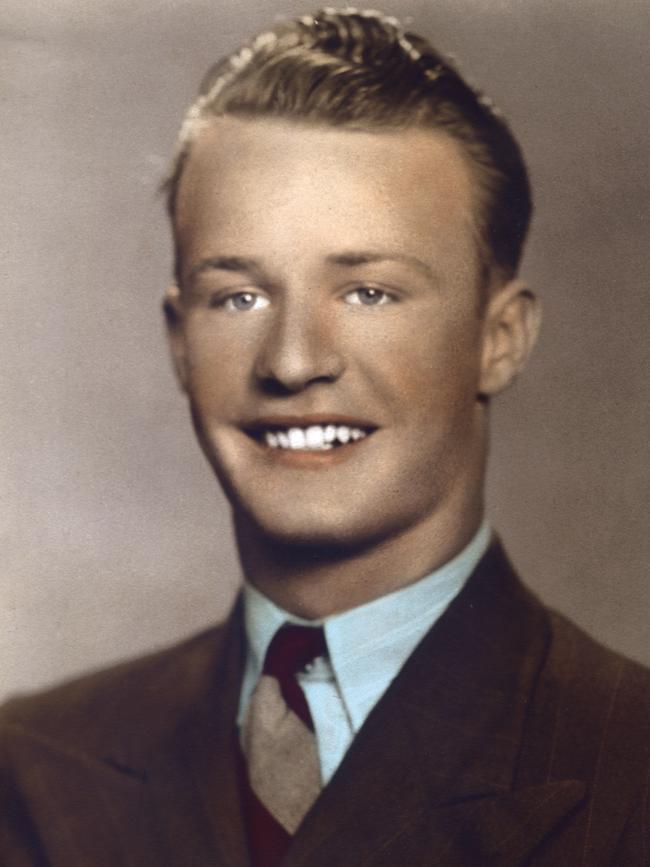
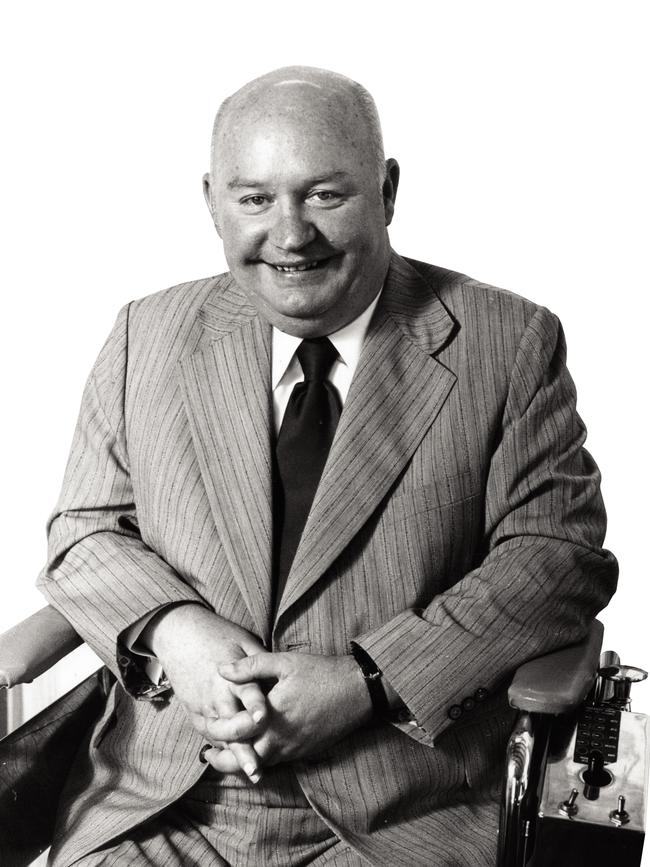
The young father had actually contracted polio, just a year before the polio vaccination was introduced to Australia, and it resulted in quadriplegia.
Two years in hospital left Watts a shell of his former self, weighing in at just 32kg, and without a job.
The once successful manager was unable to find a job and he was shunned by his community.
“Restaurants would refuse to have disabled people on the basis that it would upset the other clients,” he is quoted as saying on the Aruma website.
“Banks and other services also felt that it would upset other customers to have that so-called ‘ugly’ person in their premises.”
Rather than see his disability as a setback, Watts worked to make his life easier by collaborating on an electric wheelchair using a deckchair and parts he sourced from a disposal store. The result was one of the first electric wheelchairs in Australia.
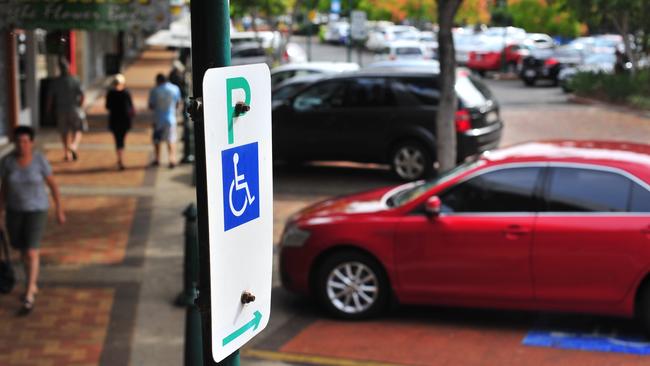
Realising there would be other people like him facing discrimination in the community, Watts established the Wheelchair and Disabled Association of Australia, which would later become House With No Steps, named after a member requested help in finding a “house with no steps” to live in.
The charity grew quickly, setting up offices around Australia to help people with a disability find jobs and live independently.
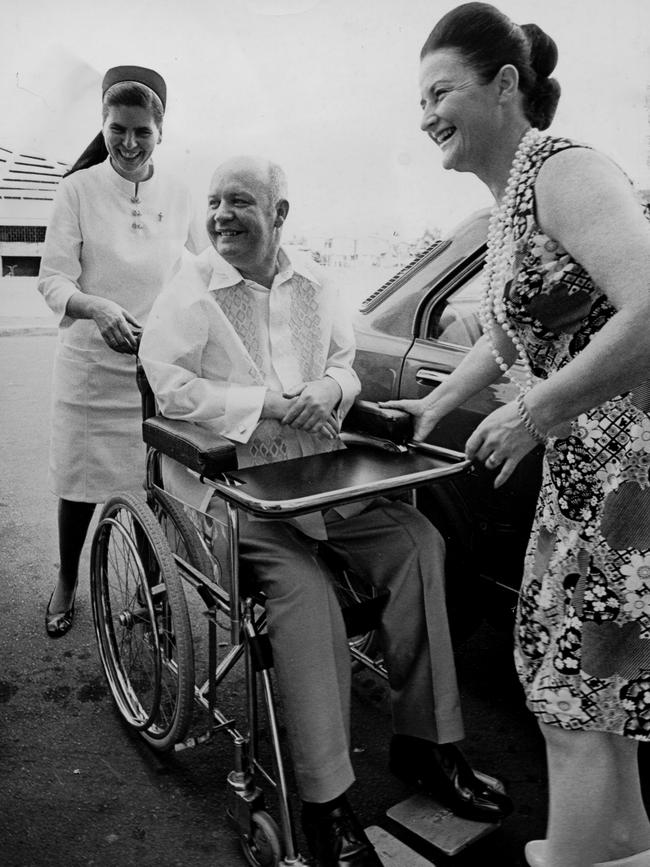
In 1969 he was elected to the national executive committee of the Australian Council for the Rehabilitation of the Disabled (ACROD) – now the National Disability Council – and the following year he was elected chairman of ACROD’s architectural barriers committee.
It was in this role that he campaigned for better wheelchair access for all public buildings, footpaths and road crossings and helped introduce parking permits for people with a disability.
Watts’ reputation as a disability pioneer and advocate spread far and wide and in 1969 he was invited to Washington DC by US president Richard Nixon for his committee on rehabilitation, an invitation which was extended another five times.
He was recognised with an MBE for his contribution to the lives of people with a disability and he was appointed a Companion of the Order of St Michael and St George in the Queen’s Birthday Honours for his work in rehabilitation.
Lionel Watts passed away in 2000 after a long illness. He is survived by his wife Dorothy and daughters Nicole and Kerry who continue to be involved in the disability charity Watts started and help keep his legacy alive.
Got a local history story to share? Email mercedes.maguire@news.com.au
VACCINE MADE POLIO RARE
Polio, or poliomyelitis, is a contagious disease that can lead to long-term disability, paralysis and death.
Polio is extremely rare in Australia today — ironically it was eradicated here in 2000, the same year Lionel Watts passed away. But sadly, that wasn’t always the case and there were major outbreaks in Australia in the 1930s, 1940s and 1950s with up to 40,000 people contracting paralytic polio in these decades.
Another coincidence is the fact the last recorded outbreak in Australia occurred in 1956, the year Watts contracted the disease. A polio vaccine was introduced here shortly after, followed by mass immunisation programs.
CHALLENGES REMAIN FOR MANY
While we have come a long way from the community attitudes that plagued Lionel Watts in the 1960s, there are still challenges.
Although we are moving towards public transport being fully accessible by 2022, 1.2 million people with a disability say it’s difficult to use it, and workforce participation is around 54 per cent compared with 83 per cent in people without a disability.
But up to 94 per cent of people with a disability have the support they need to live in private residences and children with a disability have higher school participation rates than those without a disability. This data is from the Australian Human Rights Commission.




